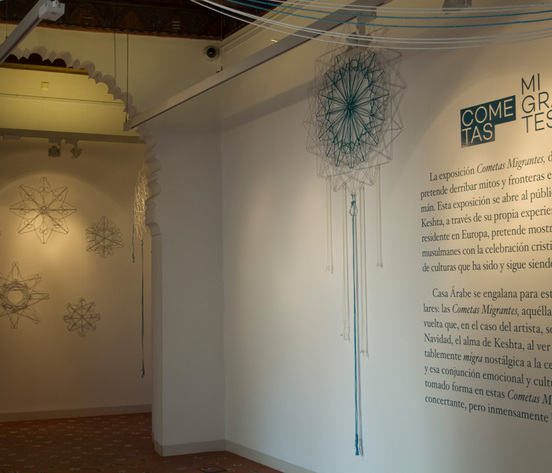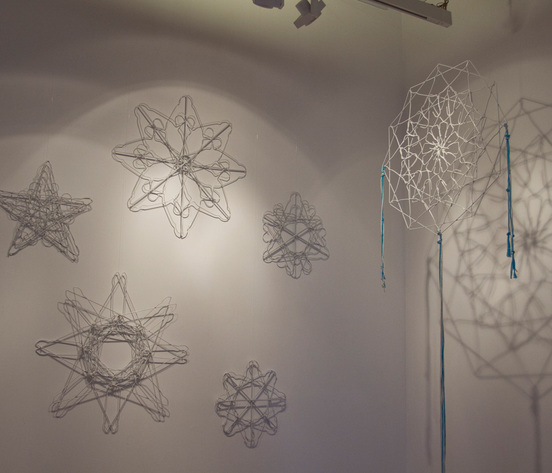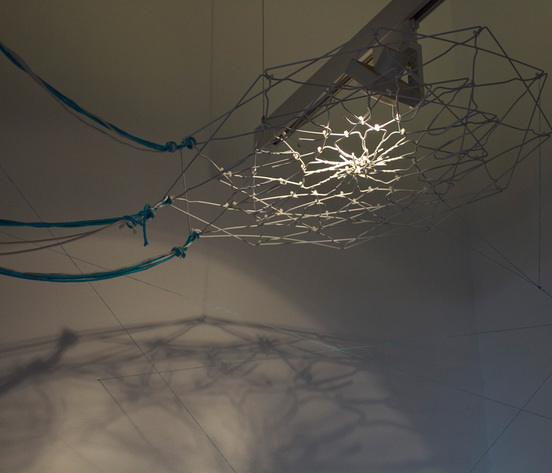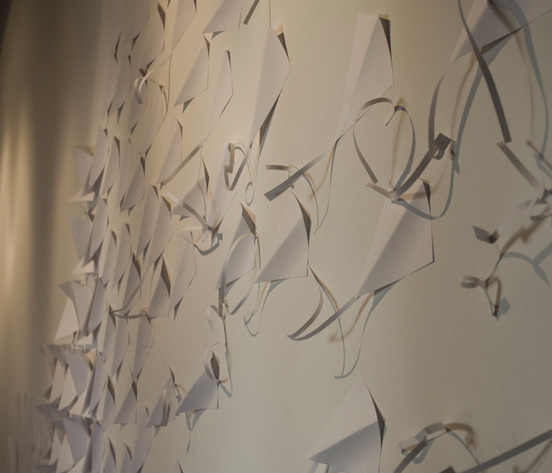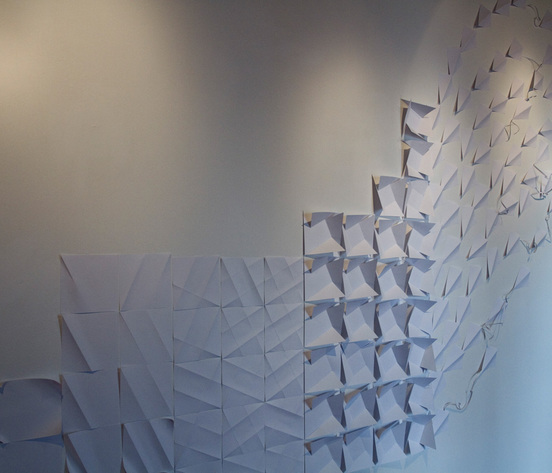Exhibitions
Index / Activities / Exhibitions / “Migrating Kites” exhibition
“Migrating Kites” exhibition
From June 18, 2015 until October 27, 2015September 1-15, Monday through Friday, from 11:00 a.m.-2:30 p.m. After those dates and until the exhibition comes to an end, it will be open Monday-Friday, from 11:00 a.m.-6:30 p.m.
CóRDOBA
Casa Árabe exhibition halls (at Calle Samuel de los Santos Gener, 9).
September 1-15, Monday through Friday, from 11:00 a.m.-2:30 p.m. After those dates and until the exhibition comes to an end, it will be open Monday-Friday, from 11:00 a.m.-6:30 p.m.
Free entrance.
Egyptian artist Ahmed Keshta is exhibiting his work in Cordoba. The
exhibition shows the similarities between Ramadan and Christmas.
The exhibition “Migrating Kites,” by Egyptian artist Ahmed Keshta (1978) is an attempt to contribute to one of Casa Árabe’s main objectives, doing away with myths and the borders between the West and the Arab and Muslim world, as already occurred at his exhibition “La Sábana,” at Casa Árabe’s headquarters in Madrid in 2014. On this occasion, Keshta, through his own personal experience, attempts to show the similarities between the Muslims’ sacred holiday and the Christmas holiday celebrated in Christianity, right inside of the melting pot of cultures that Cordoba is and has always been. To do so, the artist has created a series of installations within Casa Árabe’s exhibition spaces. They allow visitors to become immersed from the very first moment inside of a puzzle, an enigma, a hybrid holiday that is disconcerting, but also beautiful and exhilarating. Both celebrations bring moments of thought about similar sets of values, equality amongst individuals, universal brotherhood, etc., regardless of which religious community one belongs to.
On this occasion, Casa Árabe has been decorated with some very peculiar kites in terms of their shape, composition and, of course, meaning: they are migrating kites. Designed on the basis of geometric motifs, when people see them without any context, they might see them as either Arab decorations used on houses and buildings during Ramadan or as Christmas ornaments. In the final instance, these hybrid kites, which undergo constant migration, are nothing other than a visual metaphor designed by their creator, and also the result of his personal experience as an Arab living in Europe. These are not emigrating kites, but rather migrant kites, like the ones that make constant trips back and forth. In the case of the artist, they are both physical and psychological. So, every Christmas, Keshta’s soul, when he sees the lights shining in Madrid or Andorra, where he currently resides, he inevitably performs a nostalgic migration to the celebrations in his native Egypt.
For this exhibition, the author has used different materials such as hangers and paper, creating a highly personal universe that instills his work with a great deal of spirituality, beauty and originality. The exhibition may be seen in Cordoba until the end of October.
Ahmed Keshta (Egypt, 1978)
To speak of Ahmed Keshta means talking about the energy and enjoyment of creation in its purest state, about the contemporary version of a Renaissance artist who handles art and sciences with similar mastery, in a series of works which seem to combine the magic of alchemy and the harmony of the cosmos.
Keshta’s work is in large part autobiographical. It is the wealth and variety of his life experiences, along with his exceptional talent and a constantly observant nature, that cause the intrinsic beauty in his work to amaze us all, despite the message in such multifaceted art.
Keshta felt an early calling towards sculpture, which he attempted to deny by studying Interior Architecture in Cairo. However, despite an excellent academic record, the day came when he could no longer ignore his calling for art, so he decided to study Applied Arts at Helwan University in Cairo, where he graduated in 2002, after a stay of two years in Germany thanks to two scholarships he received from the Goethe Institute. This European stay was crucial in his later life and work, eventually leading him to Pietrasanta, Italy (2004 and 2008) to learn granite sculpture technique with the great masters. His European journey ended up with him taking up residence in Andorra, where he currently lives with his family. After several years devoted mainly to stone sculpture, an ongoing search for new challenges led Keshta to the world of installations and the use of materials quite distant from the well-established canons: CDs, paper…and mainly hangers. It is precisely in these elegant, subtle installations that the author, using the simplest of materials, manages to stir up sublime emotions.
Keshta has had exhibitions at, amongst other places, the Museum of Modern Art in Egypt (2007 and 2013); the Embassy of Egypt in Paris (2011); the Visual Art Center, Qatar (2012); the KAPSARC Collection, Riyadh, Saudi Arabia (2013); Schönborn Palace in Vienna, Austria (2014); at several sites in Andorra; in Madrid’s Retiro Park (2014); Casa Árabe (2014), and currently at Casa Árabe’s headquarters in Córdoba.
His work forms part of public and private collections in Spain, Andorra, France, Egypt and Saudi Arabia. Amongst the awards he has won most recently is First Prize in 2013 for design, for the trophy of the prestigious Jameel Photography Award in Saudi Arabia.
On this occasion, Casa Árabe has been decorated with some very peculiar kites in terms of their shape, composition and, of course, meaning: they are migrating kites. Designed on the basis of geometric motifs, when people see them without any context, they might see them as either Arab decorations used on houses and buildings during Ramadan or as Christmas ornaments. In the final instance, these hybrid kites, which undergo constant migration, are nothing other than a visual metaphor designed by their creator, and also the result of his personal experience as an Arab living in Europe. These are not emigrating kites, but rather migrant kites, like the ones that make constant trips back and forth. In the case of the artist, they are both physical and psychological. So, every Christmas, Keshta’s soul, when he sees the lights shining in Madrid or Andorra, where he currently resides, he inevitably performs a nostalgic migration to the celebrations in his native Egypt.
For this exhibition, the author has used different materials such as hangers and paper, creating a highly personal universe that instills his work with a great deal of spirituality, beauty and originality. The exhibition may be seen in Cordoba until the end of October.
Ahmed Keshta (Egypt, 1978)
To speak of Ahmed Keshta means talking about the energy and enjoyment of creation in its purest state, about the contemporary version of a Renaissance artist who handles art and sciences with similar mastery, in a series of works which seem to combine the magic of alchemy and the harmony of the cosmos.
Keshta’s work is in large part autobiographical. It is the wealth and variety of his life experiences, along with his exceptional talent and a constantly observant nature, that cause the intrinsic beauty in his work to amaze us all, despite the message in such multifaceted art.
Keshta felt an early calling towards sculpture, which he attempted to deny by studying Interior Architecture in Cairo. However, despite an excellent academic record, the day came when he could no longer ignore his calling for art, so he decided to study Applied Arts at Helwan University in Cairo, where he graduated in 2002, after a stay of two years in Germany thanks to two scholarships he received from the Goethe Institute. This European stay was crucial in his later life and work, eventually leading him to Pietrasanta, Italy (2004 and 2008) to learn granite sculpture technique with the great masters. His European journey ended up with him taking up residence in Andorra, where he currently lives with his family. After several years devoted mainly to stone sculpture, an ongoing search for new challenges led Keshta to the world of installations and the use of materials quite distant from the well-established canons: CDs, paper…and mainly hangers. It is precisely in these elegant, subtle installations that the author, using the simplest of materials, manages to stir up sublime emotions.
Keshta has had exhibitions at, amongst other places, the Museum of Modern Art in Egypt (2007 and 2013); the Embassy of Egypt in Paris (2011); the Visual Art Center, Qatar (2012); the KAPSARC Collection, Riyadh, Saudi Arabia (2013); Schönborn Palace in Vienna, Austria (2014); at several sites in Andorra; in Madrid’s Retiro Park (2014); Casa Árabe (2014), and currently at Casa Árabe’s headquarters in Córdoba.
His work forms part of public and private collections in Spain, Andorra, France, Egypt and Saudi Arabia. Amongst the awards he has won most recently is First Prize in 2013 for design, for the trophy of the prestigious Jameel Photography Award in Saudi Arabia.

